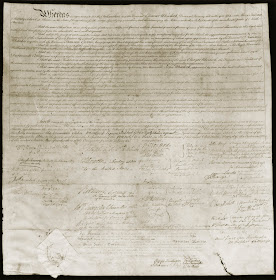 This document, which is much more impressive when you see it in real life since it is quite large at 26.5 x 27 inches, is John Wheelock's passport. Though actually a letter of introduction, it served a similar purpose to today's modern document and contains the signatures of George Washington and congressional members representing twelve of the thirteen colonies, all of whom supported John's mission to Europe to raise additional funds for the fledgling college.
This document, which is much more impressive when you see it in real life since it is quite large at 26.5 x 27 inches, is John Wheelock's passport. Though actually a letter of introduction, it served a similar purpose to today's modern document and contains the signatures of George Washington and congressional members representing twelve of the thirteen colonies, all of whom supported John's mission to Europe to raise additional funds for the fledgling college. |
| Washington's Signature |
In 1765 he sent Occom, in the company of another minister, Nathaniel Whitaker to England to raise funds so that he could start a school. People flocked to see Occom preach and his performances must have been impressive because the trip was a resounding success as Occom and Whittaker collected about £12,000 - the approximate equivalent of $1.3 million dollars in today’s money. They reported £9494 raised in England and another £2529 raised in Scotland - though the Scottish money was never actually received. The money allowed Wheelock to begin the process of creating the institution that would in 1769 become Dartmouth College, which he named after one of the most generous English donors, Lord Dartmouth.
 |
| John Wheelock |
Unfortunately, John Wheelock’s venture was not as well favored. He and his brother James set out for France and on arrival in Paris met with Benjamin Franklin who was polite, but less than happy to see them. Franklin was just arranging for a large grant in aid from the French government and did not want to damage his prospects. He packed the Wheelock brothers off to the Netherlands as quickly as he could, where they managed to raise some funds, but the burgeoning peace agreement between England and the U.S. and its potential damage to Dutch trade prevented the level of giving they had hoped for. They next traveled to England where their reception was cool, but polite. While a few people were willing to give to their cause the takings were minimal.
On the return voyage their ship sank in a storm off the coast of Cape Cod and all the money, instruments and documents they were carrying were lost causing John’s detractors to claim that the trip barely paid for itself. The irony is that despite this early set back, John Wheelock, who is a bit of a villain in the history of the College, brought Dartmouth to financial solvency for the first time in its history before he died.
Ask for Mss 781681 to see the "passport."
As so often occurs, this muddles the story of Wheelock's Indian School with that of Dartmouth College. It's a confusion Wheelock intended. He gave up on educating Native Americans. Educating the sons of colonists was more promising and lucrative. But he needed to tap into the money raised for the Indian School. So he moved the education of Indians from last on his list in the first six drafts of the charter to first. But Lord Dartmouth never succumbed. He never gave a penny to Dartmouth College. Oh, and Dartmouth eventually received the money from the Scottish Trust, but it took a long time.
ReplyDeleteWhile Lord Dartmouth never gave money to the College, he did give £50 to support the Indian School and this money was used by Wheelock to found the College.
ReplyDeleteBetween the creation of the Scottish Fund and its dissolution, disbursements were made to the College to support Indian students and to individual Indians (some not associated with Dartmouth College). The bulk of the fund remained in Scotland under the auspices of the Society in Scotland for Propagating Christian Knowledge. Dartmouth College presidents were forced to submit requests to the Society, some of which were fulfilled and others denied.
In 1922, the Society petitioned the Court of Sessions to allow them to divert the Moore’s Indian Mission Fund to general missionary work. The Court granted the petition. At the time the balance of the fund stood at £10,296, the modern equivalent of £1,730,000.00 (based on average earnings).
Peter Carini
College Archivist